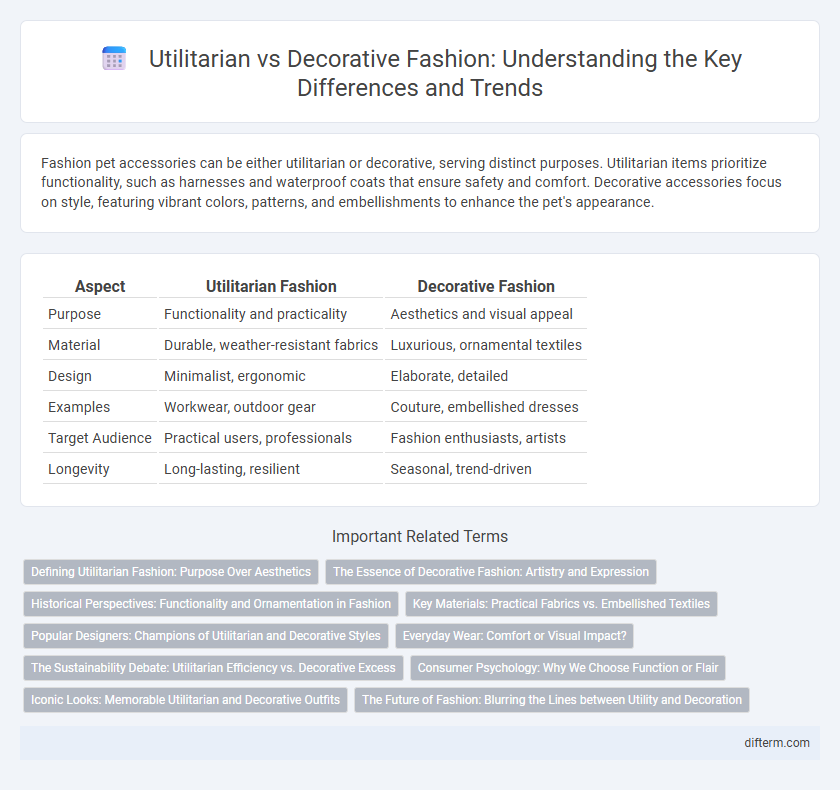Fashion pet accessories can be either utilitarian or decorative, serving distinct purposes. Utilitarian items prioritize functionality, such as harnesses and waterproof coats that ensure safety and comfort. Decorative accessories focus on style, featuring vibrant colors, patterns, and embellishments to enhance the pet's appearance.
Table of Comparison
| Aspect | Utilitarian Fashion | Decorative Fashion |
|---|---|---|
| Purpose | Functionality and practicality | Aesthetics and visual appeal |
| Material | Durable, weather-resistant fabrics | Luxurious, ornamental textiles |
| Design | Minimalist, ergonomic | Elaborate, detailed |
| Examples | Workwear, outdoor gear | Couture, embellished dresses |
| Target Audience | Practical users, professionals | Fashion enthusiasts, artists |
| Longevity | Long-lasting, resilient | Seasonal, trend-driven |
Defining Utilitarian Fashion: Purpose Over Aesthetics
Utilitarian fashion emphasizes functionality and practicality, prioritizing comfort, durability, and adaptability for everyday wear or specific tasks. Garments like cargo pants, work boots, and weather-resistant jackets are designed to meet the demands of active lifestyles while maintaining minimal decorative elements. This style reflects a commitment to purposeful design, where the primary focus is on utility rather than ornamental aesthetics.
The Essence of Decorative Fashion: Artistry and Expression
Decorative fashion prioritizes artistry and personal expression through intricate embellishments, bold patterns, and unique textures that transform clothing into wearable art. It emphasizes aesthetics over functionality, often incorporating elements such as embroidery, sequins, and hand-painted designs to convey cultural narratives or individual creativity. This approach celebrates visual storytelling, making garments not only fashion statements but also reflections of identity and emotion.
Historical Perspectives: Functionality and Ornamentation in Fashion
Historical perspectives on fashion reveal a dynamic interplay between utilitarian function and decorative ornamentation, where early garments primarily served practical purposes such as protection and status indication. Over time, ornamentation evolved to symbolize wealth, cultural identity, and social distinction, often incorporating intricate embroidery, jewelry, and luxurious fabrics. Key eras like the Renaissance and Victorian period exemplify this duality, blending functionality with elaborate design to reflect societal values and technological advancements.
Key Materials: Practical Fabrics vs. Embellished Textiles
Practical fabrics such as cotton, denim, and nylon dominate utilitarian fashion for their durability, breathability, and ease of maintenance, essential for functional clothing. In contrast, decorative fashion often relies on embellished textiles like sequined silks, embroidered velvets, and lace, prioritizing visual impact and intricate craftsmanship. The choice between practical and embellished materials reflects a balance between functionality and aesthetic appeal in contemporary fashion design.
Popular Designers: Champions of Utilitarian and Decorative Styles
Popular designers like Alexander Wang champion utilitarian fashion by integrating functionality with sleek, minimalist aesthetics, emphasizing practicality through durable fabrics and versatile silhouettes. In contrast, designers such as Valentino excel in decorative styles, utilizing intricate embellishments, vibrant patterns, and luxurious textures to create visually stunning pieces that prioritize artistic expression. This dynamic between utilitarian and decorative fashion highlights the diverse approaches to design, balancing performance-driven concepts with ornamental creativity.
Everyday Wear: Comfort or Visual Impact?
Everyday wear balances utilitarian function with decorative appeal, prioritizing comfort through breathable fabrics and ergonomic designs while incorporating visually impactful elements like bold colors and unique patterns. Functional features such as adjustable fits and durable materials enhance practicality without sacrificing style. This fusion ensures garments meet daily demands while expressing personal aesthetics.
The Sustainability Debate: Utilitarian Efficiency vs. Decorative Excess
Utilitarian fashion emphasizes sustainability through durability, multifunctionality, and minimal waste, reducing environmental impact by prioritizing practical design and long-lasting materials. Decorative fashion often drives overconsumption and textile waste due to trend-driven, ornamental pieces with limited wearability and rapid obsolescence. Balancing utilitarian efficiency with aesthetic appeal remains crucial in advancing eco-conscious consumer choices within the fashion industry's sustainability debate.
Consumer Psychology: Why We Choose Function or Flair
Consumers often weigh utilitarian value against decorative appeal when selecting fashion items, guided by psychological triggers such as self-expression and practicality. Functional apparel meets needs for comfort and durability, appealing to rational decision-making processes focused on cost-efficiency and lifestyle compatibility. Decorative fashion, on the other hand, satisfies emotional desires for identity affirmation and social signaling, influencing purchase behavior through symbolic meanings and trend alignment.
Iconic Looks: Memorable Utilitarian and Decorative Outfits
Iconic fashion moments often balance utilitarian function with decorative appeal, such as Coco Chanel's timeless little black dress blending simplicity and elegance for versatile wear. The military-inspired trench coat, originally designed for practical use, has become a decorative staple in contemporary wardrobes symbolizing both form and function. Designers like Alexander McQueen have famously merged utility with avant-garde aesthetics, creating memorable looks that challenge traditional fashion boundaries.
The Future of Fashion: Blurring the Lines between Utility and Decoration
The future of fashion increasingly merges utilitarian functionality with decorative aesthetics, creating garments that serve practical purposes while making bold style statements. Innovations in smart textiles and wearable technology enable clothing to adapt to environmental conditions and user needs without sacrificing visual appeal. This fusion of utility and ornamentation redefines fashion by prioritizing both performance and personal expression.
utilitarian vs decorative Infographic

 difterm.com
difterm.com